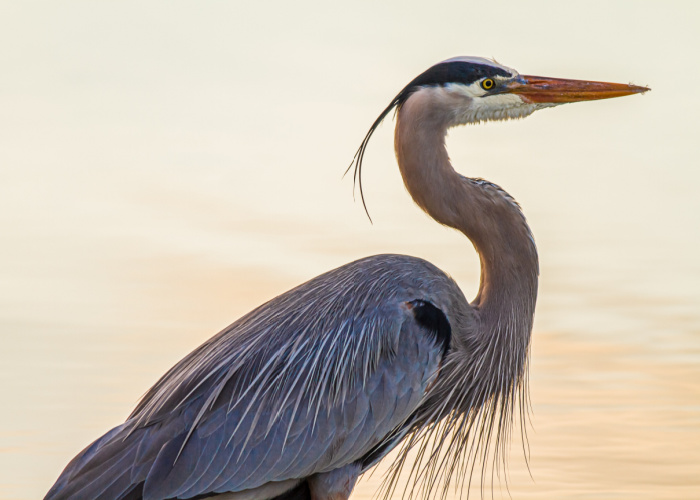There’s just something about the saltmarsh that evokes strength, resilience and vitality.
It’s the layers upon layers of intertwined marshgrass acting as a fluid buffer between the incoming water and land. It’s the pungent foundation of pluff mud enduring the relentless flux of flooding and drought, working double duty by trapping carbon. It’s the sight of shorebirds steadily wading through the water, and the knowledge of sheltered marine life lurking below the water’s surface. It’s the safe haven young sea turtles need, offering nourishment and protection against larger threats offshore.
 A great blue heron in the saltmarsh
A great blue heron in the saltmarshThe saltmarsh is more than just a tranquil backdrop of the Lowcountry — it’s a critical component to sustaining life and thwarting climate change.
The Solution Includes the Saltmarsh
There’s no doubt that the saltmarsh is an important player in the ongoing pursuit of climate solutions. The natural barrier it provides against the rising tides, coupled with its absorbent role as a carbon sink, makes the saltmarsh invaluable. It’s a natural barricade and an important element in ongoing conversations to implement green infrastructure for coastal communities.
Green infrastructure is a collaborative framework that incorporates nature-based solutions into resilience planning, especially with managing water-related impacts. Instead of working against or eliminating wild habitats to construct manmade alternatives, we can actively incorporate them and use their natural abilities to our advantage.
Green infrastructure can take on many forms. It’s harvesting rainwater in barrels to repurpose rather than installing gutters to redirect runoff. It’s planting rows of trees along busy streets to absorb excess water instead of building costly drainage systems. It’s revitalizing large green spaces in lieu of erecting elaborate architecture for community gathering. And of course, it’s honoring the role of the saltmarsh and actively protecting it.
Now, what happens when the saltmarsh undergoes significant damage and decline caused by human development or extreme weather events? We lose an entire natural line of defense against storm surge and rising seas.
Building Back Nature’s Barrier
Together, we can cultivate protection against climate change by reclaiming and replenishing the saltmarsh landscape. Planting marshgrass shoots in coordinated locations can lead to a flourishing habitat, as marshgrass has an extensive underground root system (called rhizomes) that can multiply and spread far and wide to produce new shoots in new locations.
 Aerial view of saltmarsh planting
Aerial view of saltmarsh plantingCurrently, the South Carolina Aquarium is working alongside the South Carolina Department of Natural Resources (SCDNR), Georgia Institute of Technology (GA Tech) and Robinson Design Engineers to restore what once was: the saltmarsh habitat within the historic Maryville township, recognized today as the Ashleyville-Maryville neighborhoods of Charleston.
Saturated in significance, the historic Maryville township was the manifestation of Mary Matthews Just, community leader and mother of renowned marine biologist E.E. Just. She envisioned a self-sustaining Black community in South Carolina, a central hub that celebrated, embodied and preserved the local history and culture. Thanks to Mary’s tenacity, her namesake and legacy, Maryville, was brought to life.
 Location of the historic Maryville township
Location of the historic Maryville townshipJust beyond Maryville’s borders, there once stood a robust saltmarsh landscape, steeped in thick marshgrass and flooded with marine life. But, after years of significant saltmarsh die-off, the land remaining is barren, leaving the current community exposed and at risk to the impacts of rising tides.
Protect the Landscapes You Love
Now you can become a part of the solution by participating in a Maryville saltmarsh planting event with the Aquarium and SCDNR. You’ll join a cohort of conservationists and citizen scientists trudging through pluff mud and planting marshgrass seedlings to replenish the saltmarsh landscape and solidify protection for the future. Note: space is limited!
Saltmarsh Planting Dates
Wednesday, May 25 | 9 a.m.–noon | Register to attend HERE.
Friday, June 10 | 9 a.m.–noon | Register to attend HERE.
Published May 8, 2022


